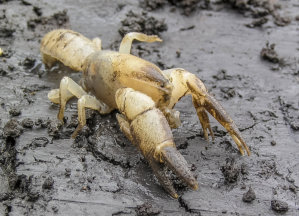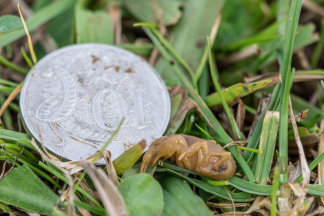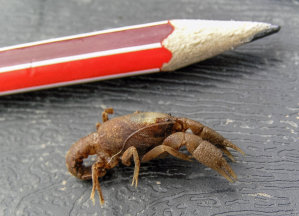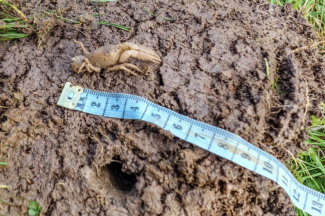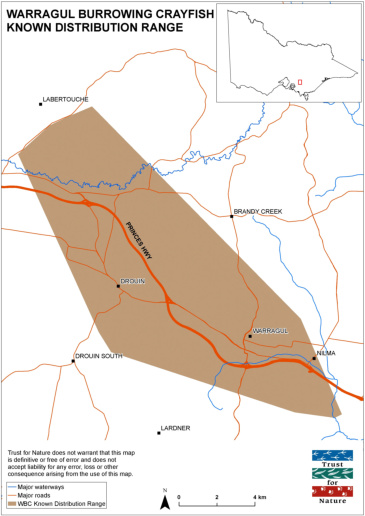Threatened Burrowing Crayfish of
West Gippsland
| Burrowing Crayfish | | Gippsland Crayfish | | Native Crayfish | | Australian Native Crayfish | | Warragul Burrowing Crayfish | | Threatened Burrowing Crayfish | | Endangered Burrowing Crayfish |
Web Site by VP-IT
All photographs © Dr. Beverley Van Praagh, Invert-Eco unless otherwise stated. No image may be saved, copied, reproduced or distributed without prior permission from the copyright owner.
Warragul Burrowing Crayfish
Everything you wanted to know about Warragul Burrowing Crayfish, but were too afraid to ask!
The Ghost-like Cray A tiny area in West Gippsland is home to a small, ghost-like burrowing crayfish called the Warragul Burrowing Crayfish. It could be called ghost-like because of its pale, creamy white hues but also because up until 2011, it was only known to inhabit a small stretch of several kilometres of creekbank along Wattle and Labertouche Creeks in Labertouche. The label associated with the Museum Victoria specimen notes that the crayfish was originally collected from the “Warragul district” in 1889, although the precise locality is not clear. It was later scientifically described in 1936 by Ellen Clark. However, it was not recorded again from Warragul until scientists stumbled across it in 2011 while hunting for the Giant Gippsland Earthworm, another famous Gippslander! It was thought that Warragul Burrowing Crayfish did not build chimneys around their burrows, which may explain why it was not found in Warragul for such a long time.Let’s Paint A Picture Of A Warragul Burrowing Crayfish (What Do They Look Like?)
Imagine a crayfish smaller than your typical “yabby” (about 70 mm in total length) with creamy yellow-white or blue-grey hues, small eyes and fine downy hairs covering
it’s back (carapace) and claws (chelae). These are the main distinguishing features of a Warragul Burrowing Crayfish. See the West Gippsland Burrowing Crayfish
section to see how these crayfish differ from other burrowing crays in the area. Like many other crayfish, the adults usually have two claws that differ in size and shape
(dimorphic chelae).
Where Do Warragul Burrowing Crayfish Call Home? A very small area of less than 20 square kilometres in West Gippsland is home to the Warragul Burrowing Crayfish. The township of Labertouche is on the western edge of their range which extends across to Drouin and Warragul in the east. That means that they are unique to a small area and are not found anywhere else in the world. This is one of the reasons that they are considered Critically Endangered (IUCN 2010 and DEPI 2009). The Life Of A Crayfish Very little is known about the life of these crayfish and they keep their secrets to themselves! They spend most of their lives in a small, underground labyrinth, probably coming to the surface at night to seek mates in spring and summer. They build their burrows down to the water table but often reside in smaller chambers closer to the surface which are filled with gooey mud. Males enter burrows of females to mate and the female carries clusters of eggs under their tail, probably throughout summer. The young likely hatch by February and become independent but may remain in the maternal burrow for some time. Several generations of Warragul Burrowing Crayfish have been recorded within the same burrow system.
Click image to enlarge

Click image to enlarge
The two main colour variations of Warragul Burrowing Crayfish
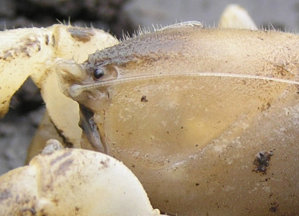
Click image to enlarge
Small eyes
Fine downy hairs
Click image to enlarge
Click image to enlarge
Young Warragul Burrowing Crayfish
Click image to enlarge

Further information:
Fact Sheet: Warragul Burrowing Crayfish - Recognising & Protecting Crayfish Habitat West Gippsland Burrowing CrayfishMap of known distribution records of
Warragul Burrowing Crayfish
Click image to enlarge
